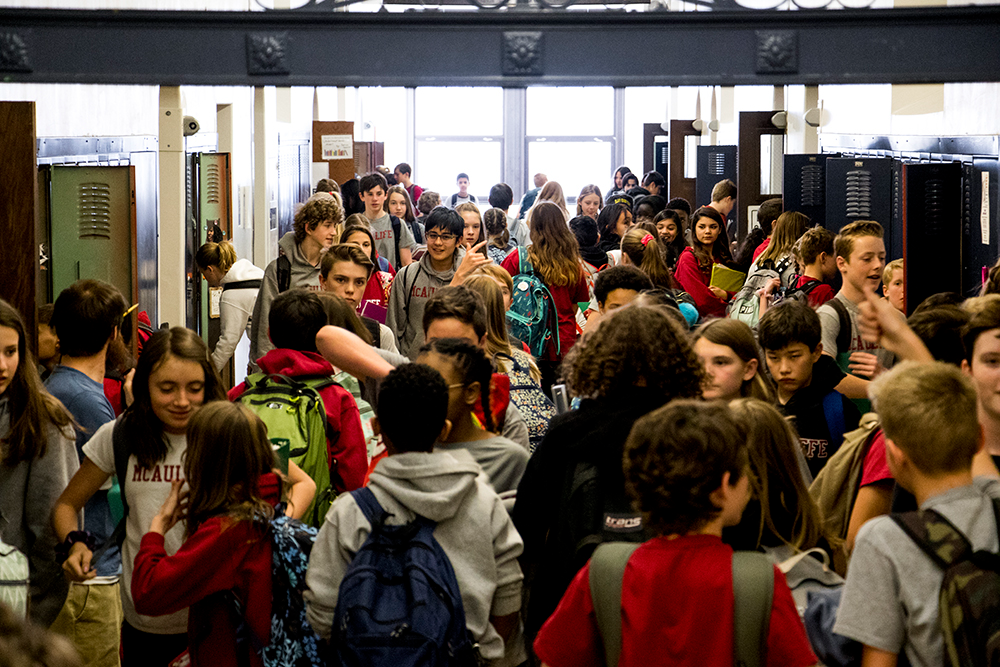
Colorado students have largely caught up to where they were academically before the pandemic and are showing gains in reading and math, but the majority of students are not on grade level, according to standardized test scores known as the Colorado Measures of Academic Success or CMAS. And the test results still show large and persistent gaps between different groups of students.
Statewide, only about 36 percent of students met or exceeded expectations in math, up 1.7 points from last year. In reading and writing, more than 44 percent of students are at or above grade level, a slight bump up from 2024.
Parents received their students' results in June, the earliest scores have ever been released.
It’s the fourth year since the pandemic that Colorado students took a normal set of standardized tests. Third- through eighth-graders took the tests in English and math, while fifth, eighth and 11th-graders took the science tests. Tests were canceled in 2020 and modified in 2021.
“We’re encouraged by the progress many student groups are making,” said Colorado Education Commissioner Susana Córdova. “At the same time, we know there is work ahead to ensure more students are meeting Colorado’s academic expectations across every grade and subject. Persistent achievement gaps highlight the importance of continuing our efforts to support every learner.”
You’ll be able to look at the data on the Colorado Department of Education website — it’s a lot of numbers in tables. I sifted through it so you don’t have to. Here are my takeaways:
1. Most students are back or beyond pre-pandemic academic levels
All grades were at or above pre-pandemic levels except reading and writing in fourth grade — a year rigor increases — and eighth grade language arts and math.
Literacy scores stayed mostly flat in the elementary grades with slight increases in middle school, with the most substantial gains in grade seven, rising 2.5 points. Last school year was the first year that all the components of Colorado’s READ Act were in place — a 2012 law meant to identify struggling readers and give them the support they need to read on grade level by third grade.
Math continues to be a bright spot, with notable gains in grades four through eight and an upward trend since 2021. Colorado has invested heavily in math using COVID relief funds. All students had free access to Zearn Math, a digital online learning program, and many schools put additional, intensive tutoring in place.
“We saw enormous declines in mathematics during the pandemic,” said Córdova. “The fact that we've seen gains year over year over year at this point, I think it's a real indication that the focus, the legislation, the resources are really paying off.”
SAT results for 11th-grade students improved in both reading and writing and math compared to last year. Scores dipped last year because it was the first year that students took the test digitally. Ninth grade PSAT 9 scores remained steady in reading and writing but declined in math, while tenth graders' scores increased 2.5 points in math and decreased the same amount in reading and writing.
2. Huge gaps between racial and ethnic groups persist
Big achievement gaps between white/Asian students and their peers persist and remain too wide, officials said. In reading and writing, gaps range from 25 to 32 points and in math, 26 to 33 points. There are also huge gaps between students based on income, language and disability status.
“They persist and continue to be too wide in some cases, even larger than they were prior to the COVID school closures,” said Córdova.
The bright spots among racial/ethnic groups are that all groups saw increases in students on grade level, particularly in seventh grade writing and in math for Black students in grades four, six, seven and eight, and in eighth-grade science compared to 2024. Hispanic students saw gains in math in grades four and eight. Notably, 10th grade Black students were the only group to show an increase in the percentage of students meeting or exceeding expectations on the PSAT assessment in reading and writing.
In terms of growth (how much year-over-year academic gain students make compared to their peers), minority students have returned to pre-pandemic levels.
3. Students learning English are recovering more slowly
Multilingual learners struggled more this year than in previous years compared to their English-speaking peers, with gaps widening to more than 30 points. About three-quarters of all multilingual learners remain in the lower performance levels.
The amount of academic growth multilingual learners make in a year has also not returned to pre-pandemic levels. Córdova said after COVID, multilingual learners were among the slowest to return for in-person schooling. An influx of students in 2023 from Venezuela and other countries — who had months of interrupted schooling — could be another factor. Córdova said a big concern is that students taking tests in Spanish also aren’t performing well.
“That's an area where something that should be an asset, we are not yet seeing the kind of gains that we would like to see and that we need to see for our students to be able to have a foundation in their first language to be able to make that strong transition into English.”
A “newcomers cohort” of districts has been meeting to share best practices for this group of students, while others have dramatically adjusted their practices.
4. Students are starting to get science
Science is a bright spot. The subject is only tested in three grades. It continues an upward trend with slight gains in fifth grade and larger increases in eighth grade (4.2 points). Christina Wirth-Hawkins, chief assessment officer with the Colorado Department of Education, said the tests and standards are tough.
“They're rigorous,” she said. “They have high expectations, there are three dimensions, so students have to integrate across content, cross-cutting concepts, science and engineering practices, and this was a bit of a transition for our educators, but we're seeing with science (scores) what we want to see, that positive upward trend.”
Overall, however, just 38 percent of fifth-graders, 32 percent of eighth-graders and a quarter of 11th graders met or exceeded expectations in science. In science, there are also large gaps between Asians/whites and their peers of 26 to 33 points.
5. Students with disabilities are testing better but not growing as quickly as their peers
Though results are low overall for students with disabilities, this year’s scores show their performance is steady or improving in some cases, with 9 to 14-point increases depending on grades. More students are meeting expectations than in 2019. However, gaps with students without disabilities are 30 points or higher. For the amount of academic progress in one year, students with disabilities did not make as much progress as their peers this year.
“That's, of course, of great concern because if our students are behind on achievement and making less growth, they're going to get further behind,” said Córdova. “We need our students who are behind to make accelerated growth.”
6. Test scores strongly correlate with the socioeconomics of a school district
Scores for major school districts run the gamut. Officials said they’re looking for districts and schools to show at least a 1.5 percentage point increase as an indicator of statistical significance or meaningful change.
In reading and writing, most large and urban districts didn’t meet that threshold except for Boulder, Littleton and Mesa Valley 51. Sheridan district, southwest of Denver, saw a significant drop in scores.
In math, on the other hand, most districts saw that 1.5 point increase, with Douglas County topping districts with a 3.2 point rise in scores. Two districts dropped in overall math scores — Pueblo 60 and Westminster.
What’s next?
Officials said improvement is not happening equally across the state. They want to accelerate academic growth this year, particularly for students who are furthest away from where they need to be. Cordova said her team will do a deep analysis of the results.
“We use this information so that we can really look at how we can learn from places that are getting outsized results but also to see where students and schools need additional supports … to direct resources where they're most urgently needed.”
The task will be all the more challenging in an environment of great budgetary uncertainty amidst Trump administration threats to cut federal education funding and Colorado’s own fiscal woes.









